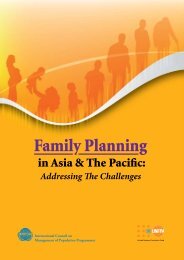SRH and HIV/AIDS Linkages at Policies, Programmes and Service ...
SRH and HIV/AIDS Linkages at Policies, Programmes and Service ...
SRH and HIV/AIDS Linkages at Policies, Programmes and Service ...
Create successful ePaper yourself
Turn your PDF publications into a flip-book with our unique Google optimized e-Paper software.
AbstractBackground: There are a number of healthpolicies <strong>and</strong> str<strong>at</strong>egies, <strong>and</strong> guidelines for<strong>HIV</strong>/<strong>AIDS</strong> programmes in Bangladesh.These include policies such as the N<strong>at</strong>ional<strong>AIDS</strong> Policy (1995), the Health, Nutrition<strong>and</strong> Popul<strong>at</strong>ion Sector Programme (2003-2010), the N<strong>at</strong>ional <strong>HIV</strong>/<strong>AIDS</strong> Str<strong>at</strong>egicPlan (2004-2010), the Adolescents SexualReproductive Health Policy, the N<strong>at</strong>ionalHealth Policy (2008), <strong>and</strong> the draftHealth Nutrition <strong>and</strong> Popul<strong>at</strong>ion SectorProgramme (2011-2016). The Ministry ofHealth <strong>and</strong> Family Welfare (MoHFW) hasamong their priorities, issues th<strong>at</strong> includesexual <strong>and</strong> reproductive health (<strong>SRH</strong>) <strong>and</strong><strong>HIV</strong>. The Department of Family Planningmanages all <strong>SRH</strong> services through aprimary health care delivery system all overthe country. The N<strong>at</strong>ional <strong>AIDS</strong> <strong>and</strong> STIsProgramme is the key organis<strong>at</strong>ion withinthe MoHFW th<strong>at</strong> manages the N<strong>at</strong>ional<strong>AIDS</strong>/STD Programme, includingservices such as voluntary counselling <strong>and</strong>testing (VCT) <strong>and</strong> antiretroviral tre<strong>at</strong>ment(ART).MethodsThe methodology used for this report wasboth a st<strong>and</strong>ard questionnaire for interview,<strong>and</strong> reviewing secondary m<strong>at</strong>erials. Indepthinterviews were carried out amongpolicy makers, heads of programmes,donors <strong>and</strong> service providers who areexperts in the field of family planning (FP),reproductive health (RH) <strong>and</strong> <strong>HIV</strong>. Thesecondary analyses of d<strong>at</strong>a was taken fromthe N<strong>at</strong>ional <strong>HIV</strong> <strong>and</strong> Adolescent SexualReproductive Health policy, str<strong>at</strong>egies, <strong>and</strong>plans, from the recently conducted roundof Behavioural Surveillance Survey (BSS),various other reports on <strong>HIV</strong>/<strong>AIDS</strong> <strong>and</strong>RH, the N<strong>at</strong>ional Communic<strong>at</strong>ion Str<strong>at</strong>egyfor Family Planning <strong>and</strong> ReproductiveHealth, Bangladesh Demographic HealthSurvey 2007 (BDHS) etc. were alsoreferenced. In addition, major NGOsworking in the field of <strong>HIV</strong>/<strong>AIDS</strong> werealso consulted.ResultsFindings of this study demonstr<strong>at</strong>e th<strong>at</strong>there is no system<strong>at</strong>ic approach to linkingsexual reproductive health (<strong>SRH</strong>) <strong>and</strong><strong>HIV</strong> <strong>at</strong> policy <strong>and</strong> system level. There isno specific str<strong>at</strong>egy for a health systemresponse to <strong>HIV</strong> <strong>and</strong> <strong>AIDS</strong> through alink with other <strong>SRH</strong> services, although<strong>SRH</strong> <strong>and</strong> <strong>HIV</strong>/<strong>AIDS</strong> are now part ofmainstream health policy. Although boththese issues are jointly addressed togetherthough <strong>SRH</strong> <strong>and</strong> <strong>HIV</strong> programmes, theyare run as separ<strong>at</strong>e entities in Bangladesh.GFATM, USAID through FHI, UNFPA,UN<strong>AIDS</strong>, DFID, World Bank <strong>and</strong> IPPFare the major funding sources in Bangladesh.However, a large portion of <strong>HIV</strong> fundingis administered by the government <strong>and</strong>development partners, including the GlobalFund.Donors have neither suggested a linkage of<strong>SRH</strong> <strong>and</strong> <strong>HIV</strong>, possibly because of theirm<strong>and</strong><strong>at</strong>e, territorial interests <strong>and</strong> differentfunding mechanisms.ConclusionThere is an urgent need for a comprehensivepackage in which RH, <strong>SRH</strong>R, STI, <strong>HIV</strong><strong>and</strong> <strong>AIDS</strong> issues are addressed with linkages.All government <strong>and</strong> non-governmentaloffices <strong>and</strong> the donor community needto have a strong horizontal <strong>and</strong> verticalcommunic<strong>at</strong>ion, to achieve the goals.The gaps <strong>and</strong> challenges need to be addressed<strong>at</strong> the policy level, with multil<strong>at</strong>eral <strong>and</strong>bil<strong>at</strong>eral commitment from donors, thegovernment <strong>and</strong> NGOs, to achieve linkagesbetween <strong>SRH</strong> <strong>and</strong> <strong>HIV</strong>.3














